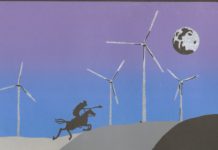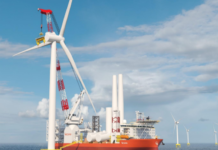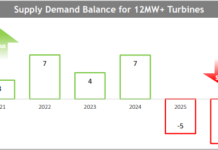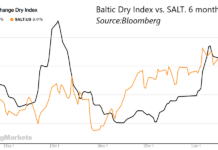Doug Young
Wind power company Ming Yang (NYSE: MY) became China’s latest new energy equipment maker to dip its toe into project finance and development last week, when it announced a new plan for a massive wind farm project in Jiangsu province. Its announcement follows similar moves by many of its peers from the solar sector, and comes as Beijing embarks on a broader plan to clean up China’s air through initiatives like clean energy development.
Plans like Ming Yang’s will certainly help China to meet its ambitious goals; but they also carry a huge burden and risk for new energy equipment makers whose own financial position is already quite tenuous as their sector emerges from a 3 year downturn. To promote healthier development, Beijing should actively encourage big state-owned companies to finance and build the dozens or even hundreds of new solar and wind farms that will be needed to help the country meet its goals.
Beijing has set an ambitious target of building 35 gigawatts of new energy power capacity by the end of next year, with Chinese firms expected to supply the big majority of wind and solar equipment needed to meet the target. The plan is designed not only to lower China’s reliance on dirtier fossil fuels, but is also aimed at promoting a battered field of new energy equipment makers that are only now emerging from a prolonged sector downturn.
Ming Yang is one of the country’s leading wind power equipment makers, and was in the headlines last week when it announced it will build new wind farms with a massive 300 gigawatts of capacity in eastern Jiangsu province. (company announcement) Ming Yang said it received approval for the project from the energy bureau in the coastal city of Rudong, and the company itself would build and operate the massive project.
Ming Yang’s plan is just the latest that is seeing new energy equipment giants like Yingli (NYSE: YGE) and Canadian Solar (Nasdaq: CSIQ) also embark on similar construction. Yingli announced in April that it would set up a 1 billion yuan ($160 million) fund with a Chinese private equity partner to build new solar plants, with Yingli supplying most of the solar cells for new construction.
Canadian Solar has also been a longtime user of the business model, which sees equipment makers build plants using their own funds, and then sell them to longer term investors after completion. Such a model is somewhat logical, as it puts project development in the hands of companies that understand the business and therefore can build plants with the biggest chances of success. Such a strategy also gives equipment makers an important sales outlet for their products.
But the business model also carries big risks for the equipment makers, who must shoulder big financial burdens for the 1-3 years required for development of new plants that can cost tens of millions of dollars. Such self-financing of new projects was partly to blame for the collapse of former industry leader Suntech, which ultimately went bankrupt. Like Suntech, most of China’s new energy equipment makers have huge debt burdens after posting losses for most of the last 3 years, and already have difficulty finding money just to support their day-to-day operations.
The financial challenges they face have been on display in the last 6 weeks, when first Yingli and then Trina Solar issued new shares to raise cash, and then saw their stocks tumble due to investor skepticism. Yingli ultimately had to sell its new shares at a 20 percent discount to their price before its announcement, while Trina offered a 15 percent discount.
A handful of major cash-rich state-owned companies have stepped forward to finance new plant construction, with names like Zhenfa New Energy and 3 Gorges New Energy announcing projects this year. Aviation Industry Corp of China was also in the headlines last month when it announced an ambitious plan to develop its solar power expertise by helping to build and fund 300 megawatts worth of solar power plants in Britain.
Beijing should encourage more of these big state-owned companies to engage in similar domestic plant construction by offering more preferential policies and also by helping to educate the companies about the fundamentals of developing economically viable projects. Doing so will remove the burden of new plant construction from the equipment makers, allowing them to focus their energies on rebuilding their financial positions and improving their products.
Bottom line: Beijing should work harder to cultivate a new generation of new energy power plant builders to help meet its ambitions construction plans.
Doug Young has lived and worked in China for 15 years, much of that as a journalist for Reuters writing about Chinese companies. He currently lives in Shanghai where he teaches financial journalism at Fudan University. He writes daily on his blog, Young´s China Business Blog, commenting on the latest developments at Chinese companies listed in the US, China and Hong Kong. He is also author of a new book about the media in China, The Party Line: How The Media Dictates Public Opinion in Modern China.







